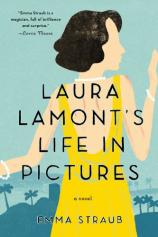Author Talk: October 26, 2012
Lauren Groff, bestselling author of ARCADIA and THE MONSTERS OF TEMPLETON, talks with Emma Straub about her new novel, LAURA LAMONT’S LIFE IN PICTURES. In the book, we follow a young actress from the idyllic countryside of early 20th-century Wisconsin to her success in the dazzling world of Hollywood. Groff asks Straub about her “opposite” trajectory from Brooklyn to Wisconsin, her favorite Hollywood starlets, and the pleasures of living with cats.
Lauren Groff: LAURA LAMONT’S LIFE IN PICTURES follows the life of your title character from when she was a little girl in Wisconsin named Elsa Emerson, through her heyday as brilliant movie star Laura Lamont, and into the years after she has grown too old for the sexy roles she was once begged to play. Tell me about this decision.
Emma Straub: For me, the idea of Hollywood is so enormous and potent, so big, that I didn't want to try to pack her whole story into just one period. Laura's experience in the 1930s is so different from her experience in the 1950s, and the 1970s, that it would be a shame not to see it all. That's what I was after --- all of it. Ha! That's not too ambitious, is it?
LG: Irving, Laura's beloved husband, at one point mentions off-handedly that he was late because he was talking to Greta Garbo on the phone. I felt a little jolt of electricity because until then I hadn't realized that I had been imagining Garbo in the role of Laura Lamont. I wouldn't suggest that you based this book on any one particular 1940s or 1950s actress, but who are your favorites from that time, and why?
ES: I was inspired to write the novel after reading an obituary of the actress Jennifer Jones, who would have been Laura's contemporary. After that, I stayed away from Jones, and to date haven't watched any of her films, because I really wanted the novel to be fiction, and not a thinly veiled take on her life. There are so many incredible actresses from that period --- my favorites would have to be Joan Fontaine, who gets a tiny shout-out in the book, because Laura loves her too, and maybe Gene Tierney, because she was so excellent in Laura. (Totally coincidental, I swear!)
LG: What attracted you to writing a novel about a film star of this era, as opposed to one about a contemporary movie star?
ES: We've got so little glamour nowadays --- I like to read Us Weekly as much as the next girl, but because of tabloid culture there's no real mystery anymore. When a star is going through a hard time, we know all about it --- when someone has a difficult pregnancy, or is getting a divorce, or is losing their mind. I wanted to go back to when people had privacy. Also, one of the aspects of Hollywood that I was interested in was the studio system, in which actors had very little power. I like to think that women movie stars today have more agency than Laura would have had.
LG: What kind of research did you do for this book?
ES: I did the best kind of research --- my husband and I did a house swap with a woman in Los Angeles, and so I spent a month sitting by the pool, soaking up all the Californian air. Well, in reality, I spent much of my time reading books at the Margaret Herrick Library, which is operated by the Academy of Motion Pictures. They have every book ever written about the history of Hollywood, and biographies of every movie star, and microfilms of all the fan magazines. I was in heaven. And, of course, I spent a lot of time watching old movies!
LG: This novel is about many things, but I found that the deepest drama was in how Laura balances her real life --- children, marriage, money, friends, grief, love --- with her career. What prompted you to write a meditation about balance?
ES: I think one of the ways that we misunderstand, or misread, other humans is by thinking about them as operating on only a single plane. I wanted to write about a woman's whole life --- that is, her love life, her family life, her work life, her friendships. My hope is that by showing all of those things, the reader will really understand who Laura is in a very deep way. Balance is so tricky, I think, especially for women. Even for a movie star.
LG: I had to laugh a little when I noticed that Laura leaves rural Wisconsin for the far more cosmopolitan Los Angeles to become a star, because your trajectory as a writer was the exact opposite: you left New York City, where you were raised, to go to Madison, Wisconsin for your MFA in fiction. How do you see acting and writing --- both creative pursuits --- either intersecting or standing in opposition to one another?
ES: What my mother would tell you is that all of the most interesting people are from Wisconsin. On the outside, writing and acting seem like they would require opposite temperaments, but I don't know if that's true. I think, for both pursuits, you need a deep curiosity about how human beings work. The main difference, I suppose, is that one is public and the other private, and clearly it seems preferable to choose the option that lets you stay home with the cats.




